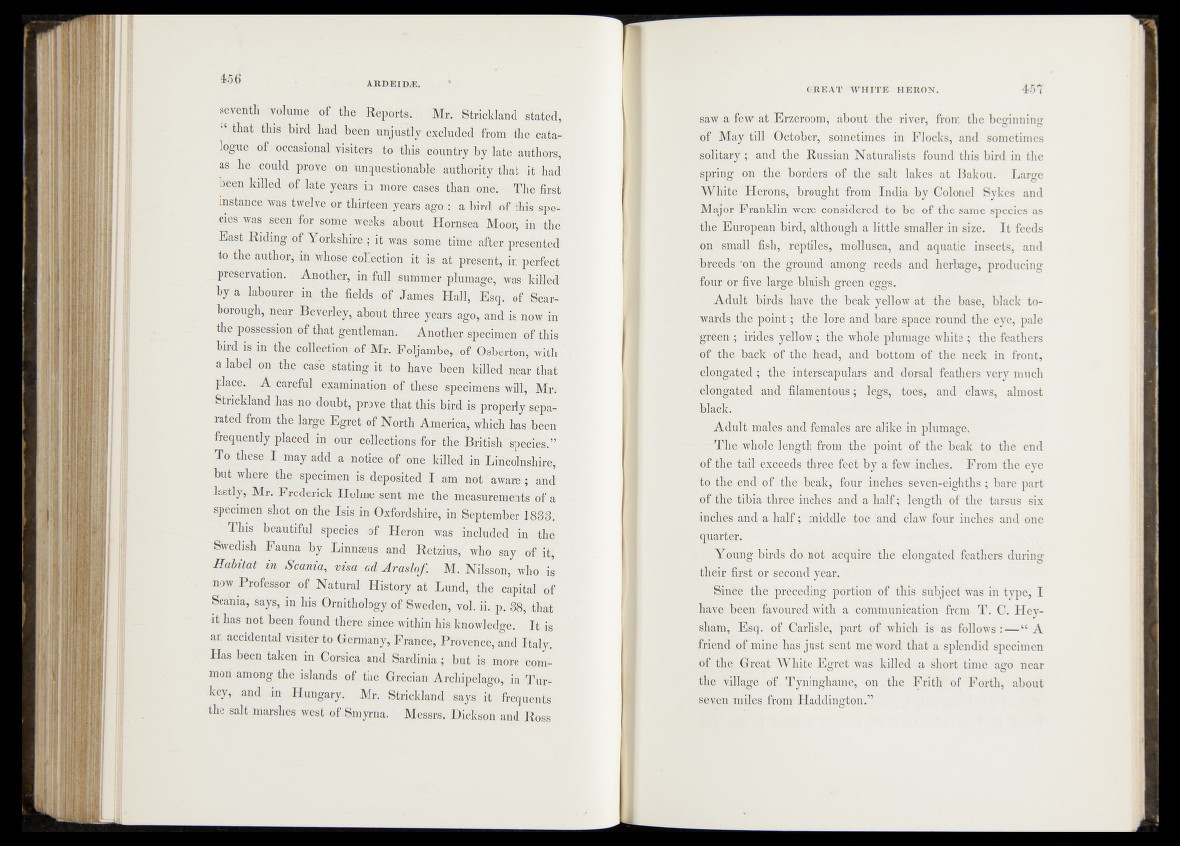
seventh volume of the Reports, Mr. Strickland stated,
“ that this bird had been unjustly, excluded from //thq’icata^’
logue of occasional visiters A.-thiâ 'country by^late -authorsv-
as--ie could prove/; on unquestionable authority'that dtriiadr
been killed of late-years in more’cases than on« .‘The first
instance *was twelve or thirteen:ymk ago,--: à bird of this .species
was- seen for some weeks about Horpsea Mecfc^in th ?
East Riding of Yorkshire ; it was götne time saftekpresènted
to the author,- in whosè collection, it is at present* imperfect
^preservation. Another,-in full summer-plumage;;iwas*killed^
by a labourer .in the fields- ó f -James Hall, Æ sq ï of^ear--
borough, near Beverley, about ^hree jear§ :agh, and dimow in
the possession of that gentleman. . A n a t h e h s ^ S n , ;® f ^ k
bird is in the eollectiomof'-Mr. Foljamb^/Qr©s’këréönr,; yitfo ‘
a label on the case .stating-it to have keen - killed /near that
place. A careful eiaminatiom-of these specimens will, Mr,
Strickland has no doubt, prove that this bird is prop^ày,àepa^
rated from the large Egret -of North America, which has-been
frequently placed in our collections for the B r i t i s k J J » . ”
To these; I . may add a notice of'one kiSed^in Ififièolhshire,.
but where the spécimen is deposited- I am hot -aware,and
lastly, Mr. Frederick Holme sent-me the-measiirementsof à
specimen shot on the-Isis in Oxfordshire, in September 1 8% •
This beautiful species -of Heron waé incMdVd"in- thè
Swedish Fauna by Linhæus and; Retzius, who say d t it,
Habitat in Scania, visa. ad Araslofi M. Nilsson, who is
now Professor; of Natural History at Lund, the capital of
Scania, says, in his Ornithology of Sweden, voLih p. 38, that
it has not been found there since within his knowledge. I t is
an accidental visiter to Germany, France, Provence, and Italy.
Has been taken in Corsica and Sardinia ; but is more com-
-mori among thé islands of the Grecian Archipelago, in Tur-
kèy» and in Hungary.- Mr. Strickland says it frequents
the salt marshes wesh of Smyrna. Messrs. Dickson and Ross
saw a few at Erzeroom, about the river, from the beginning'
of May till October, sometimes in Flocks, and sometimes
? # lita ry a n d the Russian Naturalists found this bird in the
spring on the borders of the salt lakes at Bakou. Large
White Herons, brought from India by Colonel Sykes and
Major Franklin were considered to be of the same species as
A e European bird, although a little smaller in size. I t feeds
on* small fish, reptiles, mollusca, and aquatic insects, and
breeds 'on the ground among_reeds and herbage, producing
four or five large bluish green eggs.
Adult- birds have the beak yellow -at the base, black towards
the point $ the lord and bare space round the eye, pale
#gAen ; irides yellow; the whole plumage white; the feathers
of the back of the head, and bottom of the neck in front,
elongated; the interscapulars and dorsal feathers very much
elongated and filamentous; legs* toes, and Claws, almost
black.
; Adult males and females are alike in plumage.
''T h e whole length from the point of the beak to the end
of the tail exceeds three feet by ay few inches. From the eye
to the end of the beak, four inches seven-eighths ; bare part
0 the tibia three inches .and a half; length of the tarsus six
inches and a half; middle toe and claw fout inches and one
quarter.
Young birds do not acquire the elongated feathers during
their first or second year.
Sinöe thé preceding portion of this subject was in type, I
have been favoured with a communication from T. C. Hey-
sham, Esq. of Carlisle, part of which is as follows —“ A
friend of mine has just sent me word that a splendid specimen
of the Great White Egret was killed a short time ago near
,the village óf Tyninghame, on the Frith of Forth, about
seven miles from Haddington.”